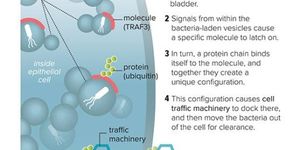Is ADAM to blame for the prevalence of asthma? Maybe, but it’s the gene and not the man. In a new study from the University of Southampton, researchers unveil the role of the gene ADAM33 in causing key characteristics of asthma. With new gene editing technologies emerging all the time, medical deletion or inhibition of ADAM33 could be a realistic method of preventing or reversing asthma.
The ADAM33 gene is not causative of asthma all by itself; it produces an enzyme that can misbehave. Normally the enzyme binds to cells in the airway muscles, but if it loses its “anchor” to the cell surface, the enzyme can cause poorer lung function in people with asthma in the form of “airway remodeling,” an asthma characteristic consisting of excess muscle and blood vessels in the airways that cause twitchiness and inflammation.
“For years we have thought that airway remodeling is the result of the inflammation caused by an allergic reaction, but our research tells us otherwise,” explained lead professor Hans Michel Haitchi, PhD.
First in their studies, the researchers showed that without the introduction of a common human allergen, the house dust mite, the human ADAM33 gene caused airway remodeling but not inflammation. It was only in the presence of the dust mite that both airway remodeling and airway inflammation levels were significantly higher.
Next, researchers conducted mice studies to observe the difference between an active ADAM33 gene and a silenced gene. As expected, they saw airway remodeling in mice with ADAM33 “switched on” since birth, and remodeling completely reversed when they modified the gene to be “switched off.”
Lastly, the researchers looked at the presence of airway remodeling and airway inflammation when subjects were still exposed to house dust mites but had the ADAM33 gene completely removed. Remodeling and inflammation levels were reduced by 50 percent and 35 percent, respectively.
“Stopping this ADAM33-induced process would prevent a harmful effect that promotes the development of allergic asthma for many of the 5.4 million people in the U.K. with this condition,” Haitchi said.
Haitchi and his team believe that their studies identify a method of preventing asthma “at the origin of the disease,” with their findings also suggesting potential for reversing aspects of the disease in current asthma patients.
“ADAM33 initiated airway remodeling and reduces the ability of the lungs to function normally,” said Haitchi. “Which is not prevented by current anti-inflammatory steroid therapy.”
Sources:
University of Southampton,
Proceedings of the American Thoracic Society









